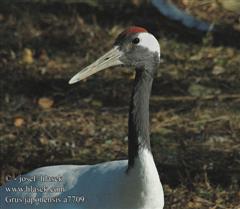Crane - Red Crowned
Red Crown Crane Scientific Name: Grus japonensis (
Tue, 29th April, 2025 - 9:45 am GMT
Sponsor Ads:

Alternative Name
Red Crown Crane Scientific Name: Grus japonensis (Basic Info
Most Red Crown Cranes are about 56 inches (140 centimeters) tall by the time they are mature. They weigh around 30 pounds (7 to 14 kilograms) and have wingspans of about 96 inches (240 centimeters). Their legs and bills are quite long. Four toes are present on each leg; three used for walking and one vestigial toe that does not reach the ground. Red Crown Cranes are predominantly white with a few black markings, mainly black feathers that are secondary plumage. These secondary feathers grow in a curling pattern, forming a lovely fluffy bustle on the Red Crown Crane. The necks are black with white napes. The bare crown of their heads is red in color, and when the crane becomes excited, this patch becomes bright red. Juvenile Red Crown Cranes are white, and their primary flight feathers have black edging. The parts of their bodies that will be black at maturity are usually grayish or sooty black.
Health
In many areas, it may be illegal for private individuals to keep these cranes in captivity, as they are listed under CITES Appendix I as a highly endangered species. Breeding Between three and four years of age, Red Crown Cranes reach sexual maturity. Red Crown Cranes mate for life, although rarely one crane may take a new mate if its partner dies. The elaborate courtship display involves a dance in which both cranes strut stiff-legged with their wings slightly extended. They will leap into the air and vocalize as well. Red Crown Cranes construct nests from reeds and grasses that are surrounded by water. Usually eggs are laid between April and May. Two eggs that will hatch in about four or five weeks are deposited, and both parents tend to the young. The first egg that was deposited hatches before the second, and normally the first chick will be larger and better cared for than the second, which rarely survives. Normally, the young Red Crown Cranes become independent when they are about ten months old.Habitat
Found in marshlandsBehavior
The beautiful Red Crown Crane has been featured in the traditions of many nations as a symbol of importance, longevity, and fidelity. Sadly, in recent years, the Red Crown Crane has become the second most endangered species of crane in the world. The distinctive call of the Red Crown Crane can be heard up to 2 miles (three and a fifth kilometers) away from its source. It is often described as a trumpeting sound. The calls of both sexes are pitched differently. Although Red Crown Cranes normally spend their days feeding in open wetland areas where they can see predators from afar, they pass their nights sleeping in deeper waters of rivers or lakes. It is thought that perhaps this is also a predator avoidance technique. These cranes sleep with one leg lifted in the air. Red Crown Cranes migrate, flying south in the winter and arriving to their northern breeding grounds again around March. They fly in a Y or reversed Y formation, and maintain exact flight formation and exact arrival dates and locations from year to year.Origin
Eastern AsiaHistory
Red Crown Cranes are native to parts of China, Korea, Russia, and Japan, where they are found in marshlands. There are many stories about Red Crown Cranes in Chinese fairy tales, and traditionally the clothing of top officials was marked with a Red Crown Crane. In Japan, Red Crown Cranes are symbols of longevity and fidelity in marriage. Korea has protected these cranes as a national monument. Sadly, these beautiful cranes are dwindling in number, mostly due to habitat loss. Although protective measures have been taken toward them, it appears that more efforts must be taken to ensure the survival of these beautiful birds.Common Foods
Red Crown Cranes spend a good deal of time foraging for foods like invertebrates, small reptiles, small mammals, fish, and small birds. They have also been known to eat grains.Sponsor Ads:
"To begin by bluster, but afterwards to take fright at the enemy's numbers, shows a supreme lack of intelligence." -- Sun Tzu, The Art of War
Crane - Red Crowned
Coded by: BGID® | ALL RIGHTS RESERVED Copyright © 2000-2025
Disclaimer | Privacy | Report Errors / Contact | Credits
















